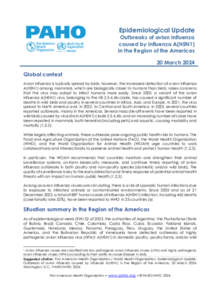Epidemiological Update Outbreaks of avian influenza caused by influenza A(H5N1) in the Region of the Americas - 20 March 2024

|
Avian influenza is typically spread by birds, however, the increased detection of avian influenza A(H5N1) among mammals, which are biologically closer to humans than birds, raises concerns that the virus may adapt to infect humans more easily. Since 2020, a variant of the avian influenza A(H5N1) virus, belonging to the H5 2.3.4.4b clade, has caused a significant number of deaths in wild birds and poultry in several countries in Africa, Asia, and Europe. In 2021, the virus spread to North America and, in 2022, to Central and South America. In 2023, several countries reported outbreaks, mainly in the Americas. Several mass die-off events have been reported in wild birds caused by virus strain A(H5N1) clade 2.3.4.4b, and an increasing number of cases have been reported in mammals, both terrestrial (including pets) and aquatic, causing morbidity and mortality.
|
